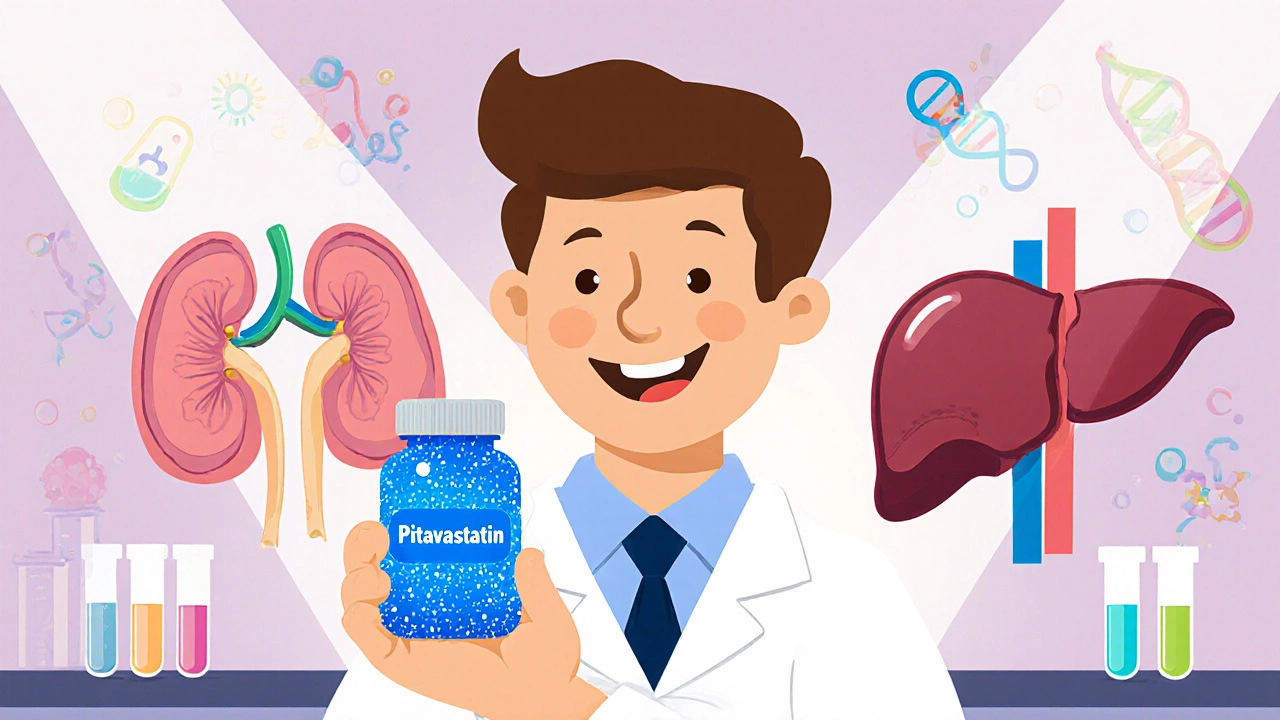Pitavastatin and Diabetes Risk: What the Latest Research Shows

Pitavastatin Diabetes Risk Calculator
Estimate your potential diabetes risk reduction when using pitavastatin versus other statins based on clinical evidence.
Estimated Risk
With pitavastatin compared to :
Current risk
0%
With pitavastatin
0%
Based on pooled data showing 12% relative risk reduction for new-onset diabetes versus atorvastatin and rosuvastatin
Quick Takeaways
- Pitavastatin shows a neutral‑to‑favorable profile for new‑onset diabetes mellitus (NODM) compared with most high‑intensity statins.
- Large meta‑analyses report a ~12% lower relative risk of diabetes versus atorvastatin and rosuvastatin.
- Mechanistic studies suggest little impact on insulin sensitivity because pitavastatin is not heavily metabolised by CYP enzymes.
- Cost and limited outcome data in diabetic patients remain the main barriers to wider adoption.
- Guidelines now list pitavastatin as a preferred moderate‑intensity option for patients with pre‑diabetes or diabetes when LDL‑C goals can be met.
What is Pitavastatin?
Pitavastatin is a synthetic HMG‑CoA reductase inhibitor developed by Kowa Pharmaceuticals and approved by the FDA in 2009 for treating hypercholesterolemia. Unlike older statins, it follows a dual elimination route-about half is cleared by the kidneys and half by the liver-so it bypasses the major cytochrome P450 pathways that cause many drug‑drug interactions.
These pharmacokinetic quirks give pitavastatin a distinct metabolic fingerprint, which researchers have scrutinised for possible effects on glucose regulation.
How Do Statins Influence Glucose Metabolism?
All statins lower LDL‑C by inhibiting HMG‑CoA reductase, the enzyme that starts cholesterol synthesis. The downstream benefits on cardiovascular risk are clear, but the same pathway also touches hepatic glucose production and peripheral insulin signalling. Some statins (especially high‑intensity ones) have been linked to modest rises in fasting glucose and HbA1c, translating into a slightly higher incidence of NODM.
The proposed mechanisms include reduced expression of GLUT‑4 transporters, altered adipocyte function, and modest weight gain. However, the magnitude of these effects varies dramatically between compounds, largely because of differences in dose, potency, and metabolic processing.

Evidence on Pitavastatin’s Diabetes Risk
The most compelling data come from a 2018 randomized trial by Kasikci et al., where men with baseline insulin resistance received 4 mg of pitavastatin daily for six months. Using euglycemic hyperinsulinemic clamps-the gold‑standard for measuring insulin sensitivity-the study found no change in hepatic or whole‑body insulin sensitivity and no increase in liver fat.
A 2022 meta‑analysis (Kim et al.) pooled results from 124,587 patients and reported a hazard ratio (HR) for NODM of 0.82 (95 % CI 0.75‑0.91) with pitavastatin, significantly lower than the HRs for atorvastatin (1.14) and rosuvastatin (1.18). The p‑value was <0.001, underscoring a robust signal.
Real‑world data reinforce the trend. Carter et al. analysed 471,250 Ontario residents and found pitavastatin reduced the relative risk of diabetes by 12 % versus atorvastatin and 15 % versus rosuvastatin over five years. Conversely, a smaller retrospective study by Cho et al. suggested a higher HR (1.67) for pitavastatin, highlighting that study design, population characteristics, and confounding variables can flip the result.
Comparative Clinical Data
Below is a snapshot of incidence rates and hazard ratios drawn from the most cited meta‑analyses and cohort studies.
| Statin | Incidence Rate | Hazard Ratio vs. Placebo | Key Study |
|---|---|---|---|
| Pitavastatin | 2.03 | 0.82 (95 % CI 0.75‑0.91) | Kim et al., 2022 |
| Atorvastatin | 2.31 | 1.14 (95 % CI 1.07‑1.22) | Carter et al., 2015 |
| Rosuvastatin | 2.45 | 1.18 (95 % CI 1.10‑1.27) | Sattar et al., 2010 |
| Pravastatin | 1.87 | 1.03 (95 % CI 0.96‑1.10) | Sattar et al., 2010 |
Practical Guidance for Clinicians
When you have a patient with elevated LDL‑C who also carries risk factors for diabetes-high BMI, impaired fasting glucose, or a Framingham Diabetes Risk Score ≥15 %-pitavastatin can be a smart first‑line choice.
- Confirm baseline fasting glucose and HbA1c before starting any statin.
- Consider pitavastatin 2 mg daily for moderate‑intensity therapy; increase to 4 mg if LDL‑C goals are not met.
- Re‑check glucose and HbA1c at 3 months, then yearly, regardless of the statin used.
- If the patient is already on a high‑intensity statin and shows rising glucose, discuss a switch to pitavastatin or pravastatin, monitoring lipid levels closely.
The American Diabetes Association (2022) notes that the benefit of any statin outweighs the modest diabetes risk for most patients. Still, for those on the edge of pre‑diabetes, choosing a statin with the most neutral glycaemic profile can tip the balance toward better overall health.
Cost, Access, and Real‑World Adoption
The price gap is stark: brand‑name pitavastatin (LIVALO) can cost around $350 USD per month, while generic atorvastatin is under $5. Medicare Part D covers pitavastatin in tier 2, yielding average co‑pays of $45 USD/month, but many private insurers still place it in higher tiers.
Prescription data from IQVIA (Q2 2024) show pitavastatin accounts for only 4.7 % of US statin fills, but its annual growth among endocrinologists treating diabetes is 18.3 % versus 2.1 % for the class overall. The main driver appears to be rising awareness of differential diabetes risk, not just cost.
Future Directions and Ongoing Trials
The PERISCOPE trial (NCT04567812), a 5,200‑patient cardiovascular outcomes study comparing pitavastatin 4 mg to atorvastatin 40 mg in diabetic cohorts, will report its primary endpoint in late 2026. If non‑inferiority for cardiovascular events and a confirmed lower diabetes incidence are shown, pitavastatin could become the go‑to statin for patients with metabolic syndrome.
Meanwhile, clinicians are urged to keep an eye on emerging real‑world evidence from electronic health‑record networks, as these data will clarify whether the modest HR reductions observed in trials translate into meaningful reductions in diabetes cases at the population level.
Does pitavastatin lower the risk of developing diabetes?
Multiple meta‑analyses and large cohort studies suggest pitavastatin carries a lower relative risk of new‑onset diabetes compared with high‑intensity statins like atorvastatin and rosuvastatin. The pooled hazard ratio is around 0.82, meaning roughly an 18 % risk reduction.
How does the dose of pitavastatin affect glucose metabolism?
Clinical trials up to 4 mg daily have not shown dose‑dependent worsening of insulin sensitivity. Even at the maximal approved dose, studies using euglycemic clamps found no significant change in hepatic or peripheral insulin action.
Should I switch my patient from atorvastatin to pitavastatin if their HbA1c is rising?
If the patient’s cardiovascular risk allows a moderate‑intensity regimen, switching to pitavastatin can be reasonable. Monitor lipid levels after the switch to ensure LDL‑C goals remain met, and re‑check HbA1c at three months.
Is pitavastatin covered by most insurance plans?
In the United States, most Medicare Part D plans list pitavastatin in tier 2, resulting in average co‑pays of $40‑$50 per month. Private plans vary, and the out‑of‑pocket cost can be substantially higher than generic statins.
What monitoring is recommended after starting pitavastatin?
Baseline fasting glucose and HbA1c, repeat at three months, then annually. Lipid panels should be checked at six weeks and then as per standard cardiovascular guidelines.

Pitavastatin’s dual clearance route means fewer drug interactions, which is a win for patients juggling meds. Its neutral effect on insulin sensitivity makes it a safer choice for those at risk of diabetes. Look at the 2018 clamp study – no drop in hepatic insulin action was seen. So if you need moderate‑intensity statin and have pre‑diabetes, consider it.
When we examine the pharmacodynamic profile of pitavastatin through the lens of contemporary lipidology, it becomes evident that its pleiotropic effects transcend mere LDL‑C reduction. The mechanistic underpinnings involve modulation of endothelial nitric oxide synthase and attenuation of oxidative stress pathways, thereby imparting a cardioprotective phenotype that is theoretically synergistic with glycemic homeostasis. Moreover, the pharmacokinetic bifurcation-renal versus hepatic clearance-circumvents the cytochrome P450 isoenzyme cascade that is notorious for precipitating adverse metabolic sequelae. Clinical trial data, particularly the Kasikci et al. 2018 randomized controlled investigation, employed the euglycemic hyperinsulinemic clamp technique, the gold standard for quantifying insulin sensitivity, and reported a null effect on both hepatic and peripheral glucose uptake. This empirical observation dovetails with the meta‑analytic synthesis by Kim et al. 2022, which aggregated over one hundred thousand patient‑years and yielded a hazard ratio of 0.82 for new‑onset diabetes mellitus in the pitavastatin cohort. By contrast, atorvastatin and rosuvastatin demonstrated hazard ratios exceeding unity, signaling a relative elevation in diabetogenic risk. From a therapeutic algorithm perspective, guidelines now stratify pitavastatin as a preferred moderate‑intensity agent in individuals with impaired fasting glucose or established diabetes, provided that LDL‑C targets remain attainable. It is also noteworthy that the cost‑effectiveness calculus remains a limiting factor, given the premium pricing of pitavastatin relative to generic statins. Nonetheless, the risk‑benefit equation tilts favorably when the clinician prioritizes metabolic neutrality alongside lipid reduction. In practice, the decision matrix should incorporate patient‑specific variables such as renal function, polypharmacy burden, and genetic polymorphisms affecting statin metabolism. The overarching principle remains that clinicians must individualize statin therapy rather than adopt a one‑size‑fits‑all paradigm. Ultimately, the emerging evidence base suggests that pitavastatin occupies a niche wherein it delivers robust atherogenic suppression without compromising glycemic equilibrium, a balance that has historically eluded high‑intensity statins. Future head‑to‑head trials will be instrumental in delineating whether the observed glycemic neutrality persists across diverse ethnic cohorts. Pharmacogenomic profiling may further refine patient selection, identifying those who metabolize pitavastatin most efficiently. Additionally, real‑world registries are beginning to capture longitudinal outcomes that could corroborate the trial data. In sum, the confluence of mechanistic rationale, clinical evidence, and guideline endorsement positions pitavastatin as a compelling option for metabolically vulnerable patients.
One could argue that the statin narrative is a curated construct designed to steer public perception of cardiovascular risk. Pitavastatin’s claim of metabolic neutrality fits neatly into that script, offering a token of safety while the underlying biochemical warfare continues unseen. The selective focus on LDL‑C eclipses the subtle perturbations in insulin signaling that may be masked by trial endpoints. Moreover, the funding sources behind many of these studies raise legitimate concerns about data impartiality. While the meta‑analysis reports a hazard ratio below one, one must question the inclusion criteria and potential cherry‑picking of favorable outcomes. In a world where pharmaceutical giants wield considerable influence, skepticism remains a healthy safeguard.
Great summary! 😊 It’s encouraging to see a statin that doesn’t jeopardize glucose control, especially for patients juggling both heart disease and pre‑diabetes. The dual elimination pathway really sets pitavastatin apart, reducing the risk of CYP‑mediated interactions. When counseling patients, I emphasize the evidence from the clamp study and the 2022 meta‑analysis to build confidence. Keep an eye on emerging real‑world data, as long‑term outcomes will further validate its place in therapy. Overall, a well‑balanced option that aligns with guideline recommendations.
Oh sure, because the pharma lobby just loves giving us miracle drugs that don’t raise blood sugar.
Even with the lower reported risk I still wonder if the data isn’t just a statistical illusion crafted to boost sales.
Honestly I’m shaking my head! 😱 The whole debate feels like a soap opera where every new statin is the “hero” of the day only to be betrayed later. Readers deserve transparency, not hype! The promise of a diabetes‑safe statin is tantalizing but the cost and limited outcomes data make me feel like I’m being led down a dark hallway with flickering lights. I’m terrified that we’ll adopt it blindly and then discover hidden pitfalls that will haunt us for years! Please, anyone, throw me a lifeline of solid, unbiased research before I lose my mind over this!
Listen, friends – while the hype train is chugging along, remember that no drug is a silver bullet. Pitavastatin looks promising on paper, but we must weigh the modest cost premium against the actual clinical benefit for each individual. If your patient already tolerates a generic statin without glycemic issues, switching just for a “neutral” label might be overkill. Stay grounded, keep monitoring glucose, and use the statin that fits your overall risk profile best. Warm wishes!